Recent Articles
Popular Makes
Body Types
Acura TSX Used Car Buyer's Guide
A Look Back At Acura's Entry Level Sedan
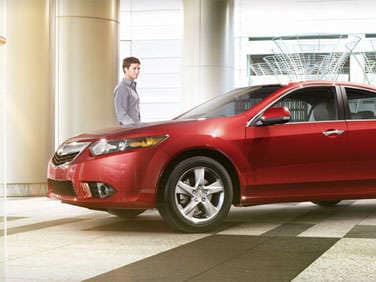
Looking for a pre-owned luxury car, with cutting-edge technology, outstanding reliability, spirited performance and an innocuous appearance? Read on, because we have the perfect car for your needs. Acura’s TSX is Honda’s upscale subsidiary’s entry-level car in the United States. Based on the European Honda Accord, also sold in Japan, South Africa, Australia and New Zealand, the TSX is great at what it does, including being often overlooked.
A certain swath of the motoring public has taken to the TSX, but mainstream success eludes the car, positioned as it is to challenge the Infiniti G25, Lexus IS250, BMW 328i, Mercedes C300, Volvo S40, and Audi A4. And while all of those cars enjoy considerable notoriety the shrinking violet image of the TSX conscribes it pretty much to the also ran category when stacked up against those cars.
This is unfortunate, because the TSX has a lot going for it, as you’re about to learn. There have been two generations of the Acura TSX offered in the U.S. since the model debuted here in April of 2003, as a 2004 model.
Acura TSX Used Car Buyer’s Guide: 2004 – 2008
The first generation TSX debuted in the U.S. with a four-cylinder engine (strike one), a taut suspension system (strike two), and rather bland styling (strike three). And while it stepped onto the playing field with three strikes against it, the model still managed to find a loyal following.
That four-cylinder engine loved to wind, and when paired with a manual transmission, despite its front-drive powertrain configuration, was a lot of fun to drive. This was aided in no small measure by the taut, all independent suspension system. Comprised of a set of double wishbones up front and a multi-link rear setup, the system endowed the model with enthusiastic handling characteristics (if not exactly a comfortably luxurious ride). In other words, the Acura really did live up to its TSX acronym, which stands for Touring Sportscar eXperimental.

2004
The 2004 Acura TSX debuted in one level of trim only, although there were differentiations made within that trim level, depending upon the equipment a particular TSX carried. Powered by a 200-horsepower, double overhead cam, 2.4-liter inline four-cylinder engine with variable valve timing, the TSX offered 166 ft-lbs of torque. The engine preferred premium unleaded fuel. A six-speed manual transmission was standard equipment for routing the engine’s output to the front wheels. A five-speed automatic transmission was available as well at no extra cost.
An entry-level luxury car, the TSX came rather comprehensively equipped. Every TSX rolled on a set of seventeen-inch alloy wheels, and benefitted from variably intermittent windshield wipers, a rear window defogger and a power-operated glass sunroof (aka a moonroof).
Heated, power adjustable sport seats for both the driver and passenger were upholstered in leather, while the rear seat back offered split-folding capability to pass-through into the trunk for added cargo capacity. The back seat also featured a center armrest with storage capability and ventilation ducts.
Remote power door locks, power mirrors, and a one touch power window for the driver were all included in the base price—as well as remote window operation. Cruise control, a front console with storage, cupholders front and rear, 12v DC power outlets, a leather wrapped tilt and telescoping steering wheel with switches for audio and cruise control, an inside remote trunk release, a universal remote transmitter (for garage doors, security gates and etc.), and front seatback storage added considerable convenience for both the driver and passengers.
Interior air was admitted through a filtration system, before being regulated by a dual zone automatic climate control system. In addition to the leather seating, the TSX enjoyed leather trim on the doors, center console and its shift knob. Ancillary lighting was provided in the trunk, there were also reading lights and illuminated vanity mirrors for the driver and the front passenger.
Front and rear floor mats were included in the base price, as were an electrochromatic rearview mirror and turn signal repeaters in the exterior rearview mirror housings. The audio system was a 360-watt, eight-speaker affair with a six-disc CD player and two subwoofers.
Safety equipment included all disc brakes with ABS, front and rear head airbags, child seat anchors, an alarm system, child safety locks on the rear doors, an engine immobilizer, Xenon headlights, a center three-point belt for the back seat, pretensioners for the front seatbelts, stability control, traction control, and electronic brakeforce distribution.
As we alluded earlier, there were different “designations” for the TSX depending upon its equipment. There was the Base model manual, the Base model manual with navigation, the base model automatic and the base model automatic with navigation. So while technically the automatic transmission and navigation system were options, because they could be bundled as “trim levels”, they weren’t options—exactly.
BTW, the navigation system was voice activated.
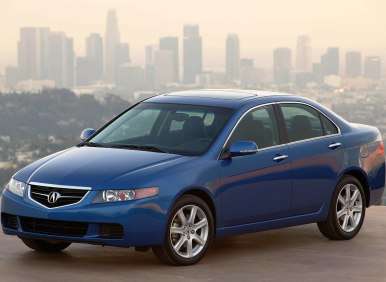
2005
For its second year on the market, Acura’s product planners added satellite radio, heated exterior mirrors, a four-way power adjustable passenger seat, and illumination for the controls on the steering wheel.
Recalibrating the engine upped power output to 205 horsepower for 2006, an appearance update garnered slightly new front and rear fascia treatments, side skirts, fog lights, and restyled wheels. Inside, a Multi-information Display was added to the instrument panel, along with two-position memory for the driver's seat adjustments. The audio system got an auxiliary MP3 player input and Bluetooth-compatible HandsFreeLink for cellular phones. The navigation system was upgraded to compute more quickly and it also included access to a Zagat restaurant rating guide.
Tire pressure monitoring was added, and the autodimming rear-view mirror was improved.
With a revised model coming up, the 2008 Acura TSX was largely unchanged from the 2007 model. The good news is the car was so comprehensively equipped right off the top, there wasn’t a whole lot for Acura to do. The bad news is the car was so comprehensively equipped right of the top, Acura didn’t have much new to brag about either.
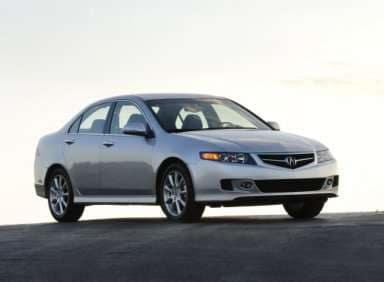
Acura TSX Used Car Buyer’s Guide: 2009 – Current (2012)
An all-new version of the TSX debuted at the 2008 New York Auto Show on April 11 of that year. Introduced as a 2009 model, the revised TSX was wider, longer and a bit heavier than the model it replaced. The 2009 TSX went on sale in July of 2008.
If you’ve read this article from the beginning we’re going to save you a lot of reading and say equipment-wise, the 2009 Acura TSX was exceedingly similar to the very impressively equipped 2008 model, which was basically the same as the 2004 model.
The big news—as far as change was concerned—was all-new styling and a new body structure designed to improve crashworthiness.
In response to the concerns from some quarters regarding the stiffnessof the TSX, the steering and suspension systems were recalibrated for the GEN2 TSX more toward the comfort end of the spectrum. This resulted in a more luxurious ride, but diminished sportiness.
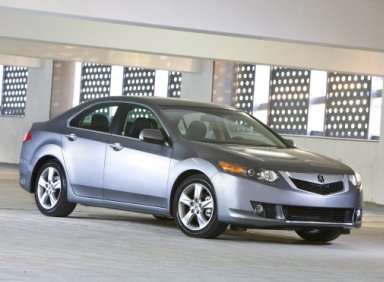
2009
Just as its predecessor, the 2009 Acura TSX featured leather seat upholstery, dual-zone climate control, a power driver's seat with memory, a sunroof, and Xenon headlights. However, a USB port music interface was added to the audio system. The 2009 TSX also offered an optional technology package, which included a rear-view camera, a voice-activated navigation system with real-time traffic and weather, and a 10-speaker premium surround sound system with DVD-audio capabilities designed by Grammy Award-winning record producer and audio engineer Elliot Scheiner.
The Acura’s 2.4-liter four-cylinder engine produced 201 horsepower and 170 ft-lbs of torque with the five-speed automatic transmission. If buyers opted for the manual transmission, they got another two ft-lbs to work with. Both transmissions cost the same, so it was basically buyer’s choice. The automatic also featured a manual shift mode via paddles on the steering wheel.
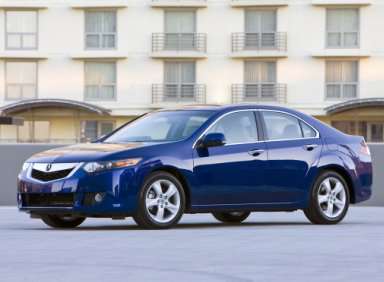
2010
The TSX got V6 power for the first time in its history. The 280-horsepower, 3.5-liter engine produced 254 ft-lbs of torque. The transmission choice was the five-speed automatic with paddle shifters. The product planning team prescribed a set of eighteen-inch alloys to go with the V6 engine and a slightly firmer suspension calibration. Additionally, the steering was tweaked to provide the impression of more weight through the wheel. If you’re looking for the “sporty” GEN2 TSX, this is the one.
The navigation system was swapped out for a hard-drive based unit and the TSX Sport Wagon debuted.
And, yeah, we buried the lead…
The Sport Wagon was actually introduced in 2010 at the New York Auto Show. Equipped largely the same as the sedan, other than its optional powered rear liftgate, mechanically it had to make do with the 2.4 liter four-cylinder engine and the five-speed automatic transmission with paddle shifters.
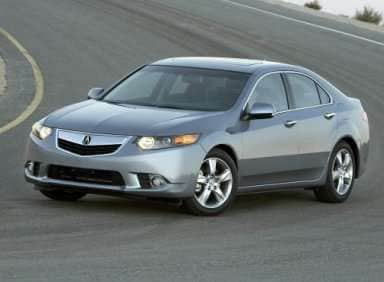
Acura TSX Used Car Buyer’s Guide: Current Model (2012)
The 2012 Acura TSX Special Edition Package fitted to the four-cylinder sedan, bundles a more aggressive front spoiler, a new rear bumper fascia, unique side sills and an exclusive “Special Edition” badge on the trunklid. In addition, the Special Edition TSX’s seventeen-inch, five-spoke aluminum wheels feature a polished finish with dark grey background.
Inside, the TSX Special Edition uses perforated black Lux Suede (faux-suede) inserts with red backing. Red stitching on the seats, steering wheel, and shift knob compliment red lighting for the instrument cluster gauges, overhead lighting, and footwell lighting.
Aluminum pedal covers and bright silver-plating for the steering-wheel-mounted paddle shifters contrast with the black headliner material (standard TSX models use grey headliner material).
In other TSX news for 2012, in an effort to free up under-floor cargo space, Acura’s planners deleted the spare tire from the Sport Wagon and replaced it with a tire repair kit.
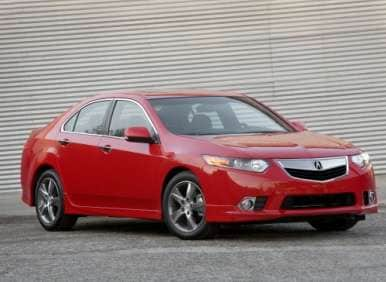
Acura TSX Used Car Buyer’s Guide: Summary
As entry-level luxury sport sedans go, the Acura TSX has a lot going for it. An abundance of tech, engaging driving dynamics, an outstanding array of standard features and the legendary reliability for which its Honda parent is quite justifiably renowned, are all compelling reasons to shop for a pre-owned TSX.
Were we considering the purchase of one, given our proclivities toward enthusiastic driving, we’d focus our search on the last two years of the first generation car. That way, we’d get the engaging driving dynamics, as well as the benefit of the majority of the tech fitted to the second generation car. Those of you who prefer a more comfortable and luxurious ride quality over spirited handling, might want to do the opposite, and focus your search on an early version of the second generation car.
Regardless of your choice, you should be in petty good shape, as the cars have a well-deserved reputation for bulletproof operation. Still, you’ll want to run a vehicle history report against the VIN of any car you’re considering. You’ll also want to do an Internet search for recall information, though the TSX hasn’t been subjected to many. Finally, you’ll want to have a trusted professional mechanic perform a pre-purchase inspection, just to make sure you’re getting a sound example of the entry-level Acura.
